APPENDIX I
STATEMENT ON COMPLIANCE WITH LAWS AND REGULATIONS
We have audited the INS' management of automation programs. We reviewed automation
program tracking, program costs and funding, contract monitoring, data integrity and
reliability, IDENT equipment inventory, and compatibility of automation projects. The
audit was conducted in accordance with generally accepted government auditing standards.
In connection with the audit, and as required by the standards, we reviewed program
activities and records to obtain reasonable assurance about the INS' compliance with laws
and regulations that, if not complied with, we believe could have a material effect on
program operations. Compliance with laws and regulations applicable to INS' management of
automation programs is the responsibility of INS management.
Our audit included examining, on a test basis, evidence about laws and regulations. The
specific laws and regulations against which we conducted our tests are contained in the
relevant portions of the Clinger-Cohen Act of 1996; the Federal Acquisition Streamlining
Act of 1994; the Chief Financial Officers Act of 1990; OMB Circular A-109, Major Systems
Acquisitions, April 5, 1976; OMB Circular A-127, Financial Management Systems, July 23,
1993; and OMB Circular A-130, Management of Federal Information Resources, February 8,
1996.
Except for those issues cited in the Findings and Recommendations section of the
report, our tests indicated that, for those items reviewed, INS was in compliance with the
laws and regulations referred to above. With respect to those transactions not tested,
nothing came to our attention that caused us to believe that INS management was not in
compliance with the laws and regulations cited above.
APPENDIX II
STATEMENT ON MANAGEMENT CONTROLS
In planning and performing our audit of the INS' management of projects in support of
its automation programs, we considered INS' management controls for the purpose of
determining our auditing procedures. This evaluation was not made for the purpose of
providing assurance on the management control structure as a whole; however, we noted
certain matters that we consider to be reportable conditions under generally accepted
government auditing standards.
Reportable conditions involve matters coming to our attention relating to significant
deficiencies in the design or operation of the management control structure that, in our
judgment, could adversely affect the INS' ability to effectively manage projects in
support of its automation programs. During our audit, we found the following management
control deficiencies.
- The INS could not sufficiently track the status of its automation programs to determine
whether progress was acceptable given the amount of time and funds already spent (see
Finding 1).
- The ultimate cost for INS' automation programs was uncertain because actual costs
incurred were unreliable and projected cost estimates unsupported (see Finding 2).
- IDENT equipment costing $520,000 remained in the INS warehouse inventory for more than
one year (see Finding 3).
Because we are not expressing an opinion on the INS' management control structure, this
statement is intended solely for the information and use of the INS in managing its
automation programs. This restriction is not intended to limit the distribution of this
report, which is a matter of public record.
APPENDIX III
OBJECTIVES, SCOPE, AND METHODOLOGY
Objectives
The purpose of our audit was to assess INS' management of projects in support of its
automation programs. Our objectives focused on areas of concern that we noted in our March
1998 OIG Report on "INS' Management of Automation Programs" (Report Number
98-09). Specifically, the objectives of our follow-up audit were to evaluate actions taken
by INS to ensure that:
- automation programs were properly tracked towards their completion;
- the cost of automation programs were properly accounted for, and that the automation
programs will be completed within estimated costs and time frames;
- contract cost was properly monitored and INS' risk for expenditures paid was minimized;
- data entered into or accessed by automation projects were reliable;
- the flow of IDENT equipment inventory was properly monitored; and,
- compatibility exists between INS' RAPS and DACS with EOIR's ANSIR system.
Scope and Methodology
Generally, our audit focused on INS automation activities during the period October
1994 through February 1998. Audit work was performed at INS' headquarters in Washington,
D.C. We also performed limited audit work at the Justice Management Division's
headquarters in Washington, D.C. Although our audit focused on INS automation activities
during the period October 1994 through March 1998, we spent subsequent months reviewing
data from that period and preparing the report. In December 1998 and January 1999, we
discussed our findings with INS and obtained additional views and data from them.
The scope of the audit was geared towards assessing the status of the following finding
areas which were presented in our earlier report. These finding areas included: (1) the
status of the automation programs, (2) the cost and funding of automation programs, (3)
the administration and monitoring of contracts, (4) data reliability, (5) the
monitoring of IDENT equipment inventory, and (6) the compatibility of automation systems
with other DOJ systems.
In order to assess the status of these finding areas, we conducted the following audit
steps. We interviewed INS, JMD and EOIR personnel to determine if appropriate actions were
taken to resolve issues presented in our prior draft report, and we reviewed applicable
laws and regulations, as well as INS policies and procedures. We also reviewed FY 1997
OIRM Monthly Progress Reports, which were cited by OIRM officials to be the best source of
information for tracking the status of the automation programs. The INS funding reports
were examined to determine the past, present and future funding needs and cost
expenditures for the automation programs. We also reviewed additional reports and
proposals to support INS' position on the status of the mentioned finding areas.
We performed the audit in accordance with generally accepted government auditing
standards and, accordingly, included such tests of the records and procedures as we deemed
necessary. However, we may not be considered by others to be completely independent of
INS, as required by the standards, because INS has reimbursed us for work that pertained
to INS fee-supported programs. Annually, the OIG receives $5 million, representing about
10 percent of its operating budget, from the INS for fee-related audits, investigations,
and inspections. Nonetheless, we consider ourselves independent and do not believe that
our reimbursement arrangement with INS has had any effect with regard to our conduct of
this audit.
APPENDIX IV
BACKGROUND
The INS automation initiatives were reconstructed into programs to better reflect the
functional areas supported by OIRM. The following briefly describes OIRM Operations and
the seven programs based on INS Quarterly Reports.
- OIRM Operations
- OIRM Operations provides the strategic direction and tactical
implementation strategies for the effective and efficient development, deployment, and
maintenance of automated information resources. While OIRM Operations is not a program, it
provides the ancillary support services and management assistance required to implement
OIRM automation programs.
- Infrastructure Program
- The Infrastructure Program consists of projects that
provide and support office automation products and services for INS. Key projects include:
Infrastructure Deployment, Infrastructure Support, and Video Teleconferencing. The goals
for Infrastructure Deployment and Infrastructure Support projects are to standardize and
integrate computer systems in each INS office and provide support for the installed
infrastructure. The primary goal for the Video Teleconferencing project is to provide
audio and video connectivity between distant locations for INS hearings and eventually to
expand to include training, briefings and meetings.
- Enforcement Systems Program
- The Enforcement Systems Program currently consists of
four key projects designed to streamline administrative enforcement activities, automate
manual intensive processes, and provide radio and surveillance equipment that can be used
to provide a more secure environment for border patrol operations. Key projects under this
program include: the ENFORCE system, the Encrypted Voice Radio Program project, the
Electronic Support project, and the ICAD project.
- Examinations Systems Program
- The Examinations Systems Program provides systems
development, deployment, and O&M services to support INS' benefit systems. The CLAIMS
project, the transition of the Immigration Card Facility functions to the INS Service
Centers, and the re-engineering of the naturalization process are the primary projects
currently being supported under this program.
- Inspections Systems Program
- The Inspections Systems Program consists of several
automation projects designed to provide core administrative and processing capabilities in
support of the INS Inspections functions. This includes the Automated Inspections Systems,
and I-94 Automation and Exit Control Systems. The Automated Inspections Systems project
should (1) improve border enforcement and facilitate inspections operations,
(2) share data between INS and the Department of State relative to non-immigrant and
immigrant visas, (3) process low-risk travelers, and (4) facilitate the inspection of
travelers who commute regularly to and from the United States. The I-94 Automation and
Exit Control Systems project should automate the collection and processing of arrivals and
departures information.
- Biometrics Systems Program
- The Biometrics Systems Program uses biometrics
recognition technology to enable INS to identify persons of interest rapidly and
accurately; e.g., criminal aliens, illegal entrants, and benefit applicants. The key
project in support of this program is IDENT.
- Corporate Information Systems Program
- The goal of the Corporate Information System
Program is to integrate and consolidate access to INS corporate information used to
support enforcement, service, and management functions, such as granting benefits,
preventing illegal entry, and managing resources. Access to corporate information will be
simplified through the use of a common user interface. Systems supported by the Corporate
Information Systems Program include: (1) the Non-Immigrant Information System,
(2) the Student and Schools System, (3) the Central Index System, (4) the
Receipt and Alien File Accountability and Control System, (5) the Systematic Alien
Verification for Entitlements system, (6) the Alien Status Verification Index, and
(7) the Status Verification System.
- Management Systems Program
- The Management Systems Program provides services to
operate and maintain existing INS financial and administrative systems, as well as
services to establish new automated information systems to meet INS' financial and
administrative tracking and reporting needs. Areas supported under this program include
budget and financial accounting services, human resources management, and procurement
administration applications.
Per the INS Quarterly Funding Profile dated June 30, 1997, expenditures for the eight
automation programs for FYs 1995 through 1997 totaled an estimated $813 million as shown
in Table 5.
COSTS OF AUTOMATION PROGRAMS
Table 5
AUTOMATION PROGRAMS |
ACTUAL COSTS
FYs 1995 -1996
(in thousands) |
ESTIMATED COSTS
FY 1997
(in thousands) |
TOTAL ESTIMATED COSTS
FYs 1995 -1997
(in thousands) |
| Infrastructure |
$ 173,077.9 |
$
96,245.9 |
$269,323.8 |
| Enforcement
Systems |
108,486.4 |
79,423.9 |
187,910.3 |
| Examinations Systems |
44,744.1 |
25,751.8
|
70,495.9 |
| Inspections
Systems |
39,684.8 |
21,642.5 |
61,327.3 |
| Biometrics Systems |
28,399.6 |
15,849.2
|
44,248.8 |
| Corporate
Information Systems |
61,470.7 |
38,811.5 |
100,282.2 |
| Management Systems |
13,629.1 |
6,369.5
|
19,998.6 |
| OIRM Operations |
28,793.5 |
31,106.1 |
59,899.6 |
| TOTAL COSTS |
$498,286.1 |
$315,200.4 |
$813,486.5 |
APPENDIX V
INS RESPONSE TO THE DRAFT REPORT
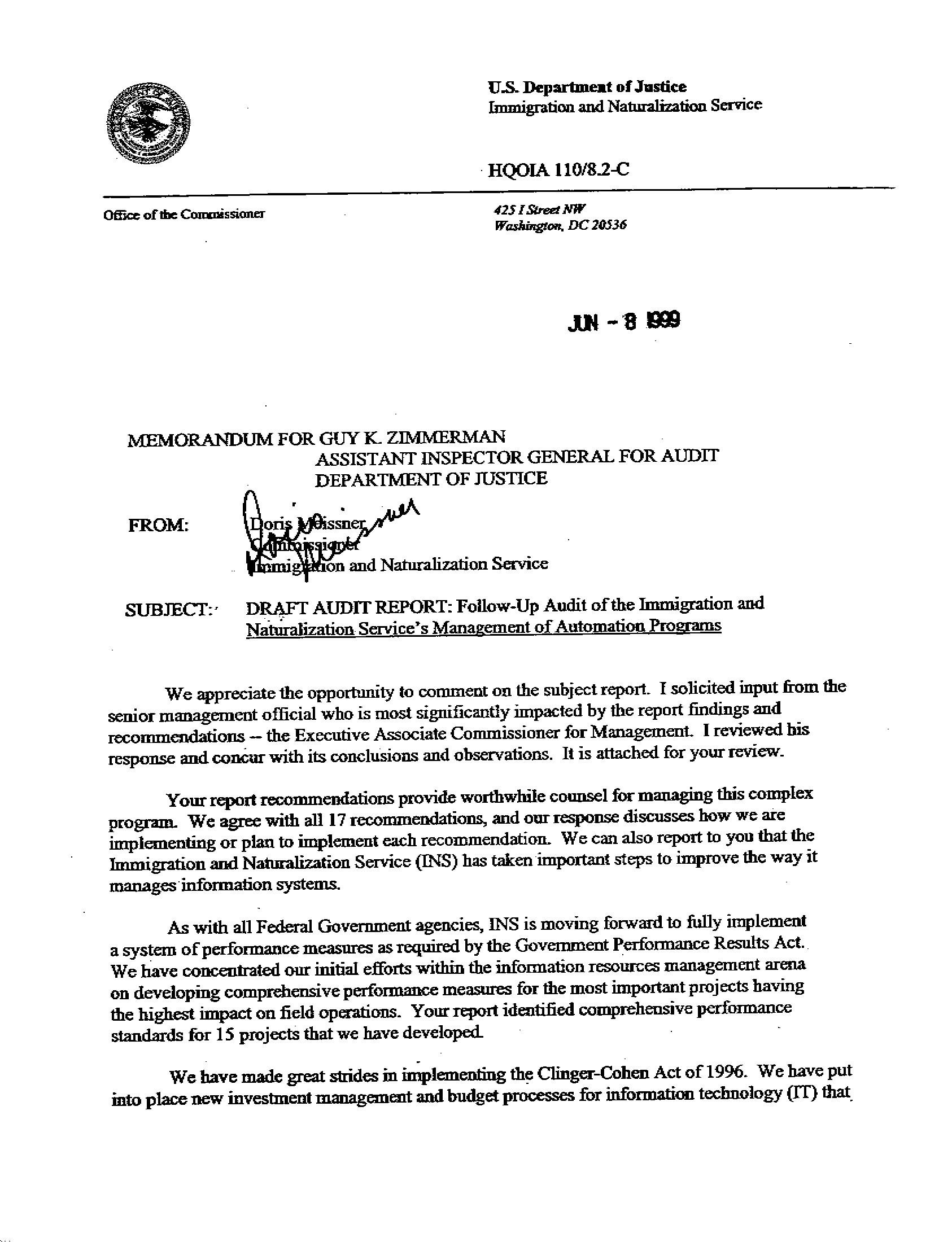
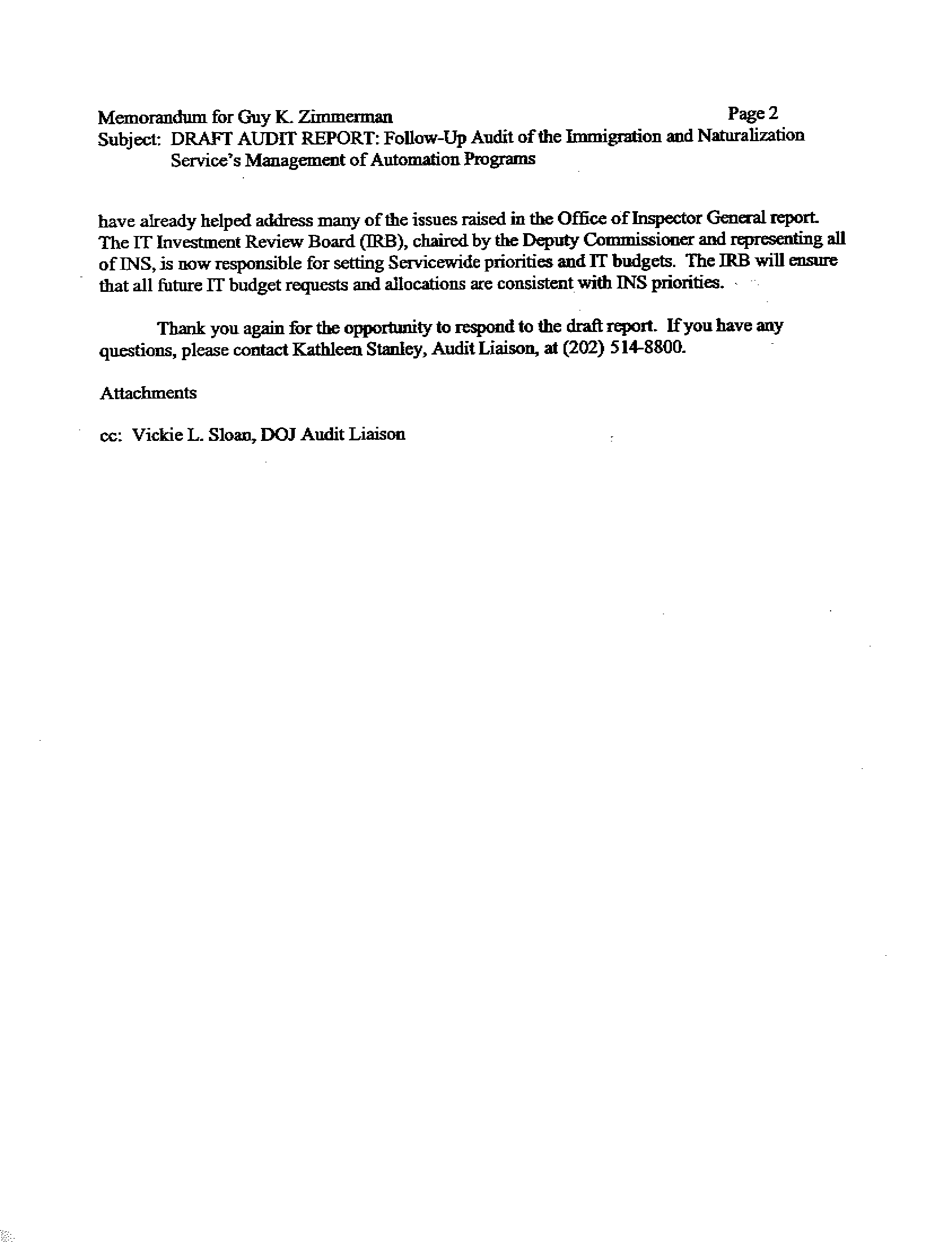
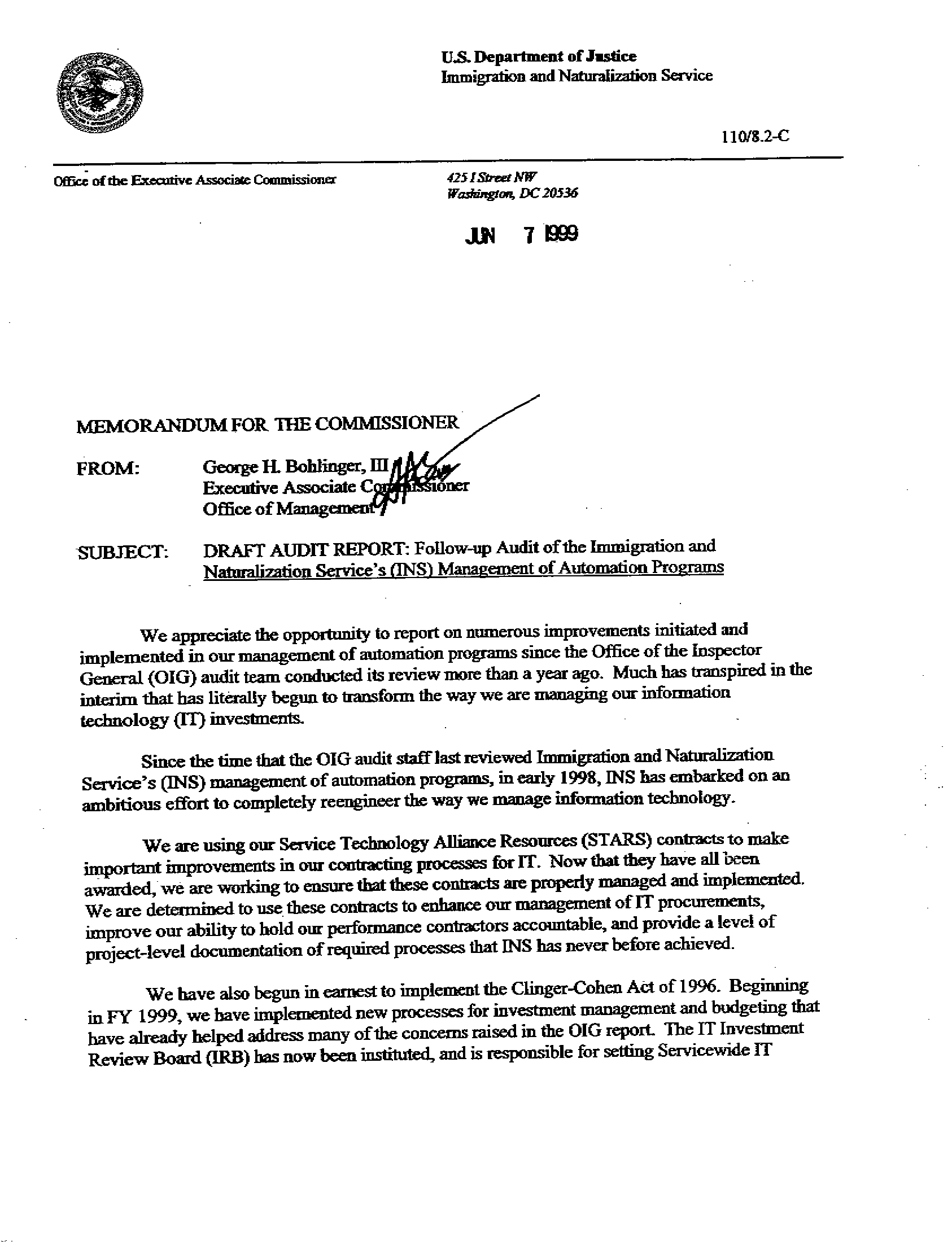
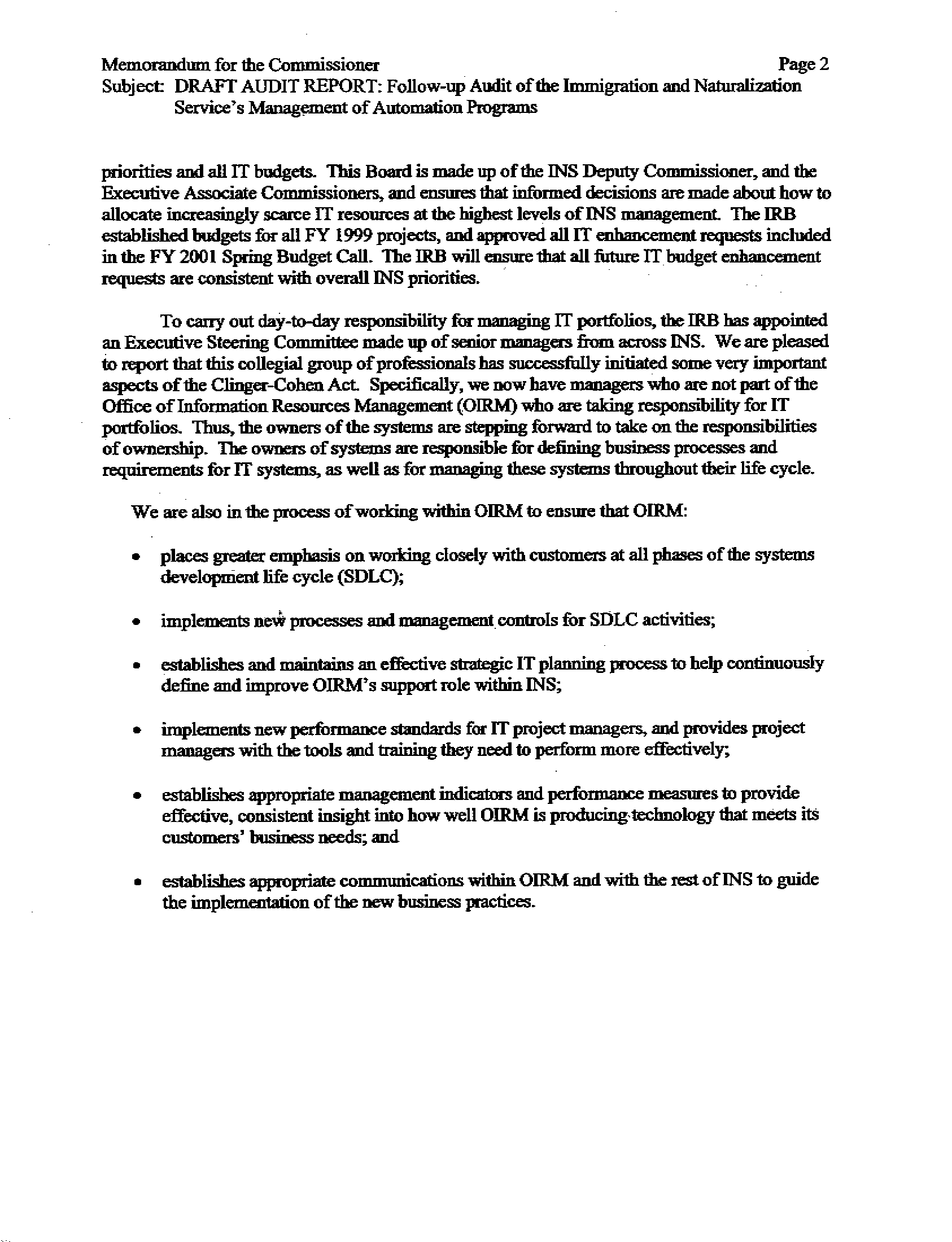
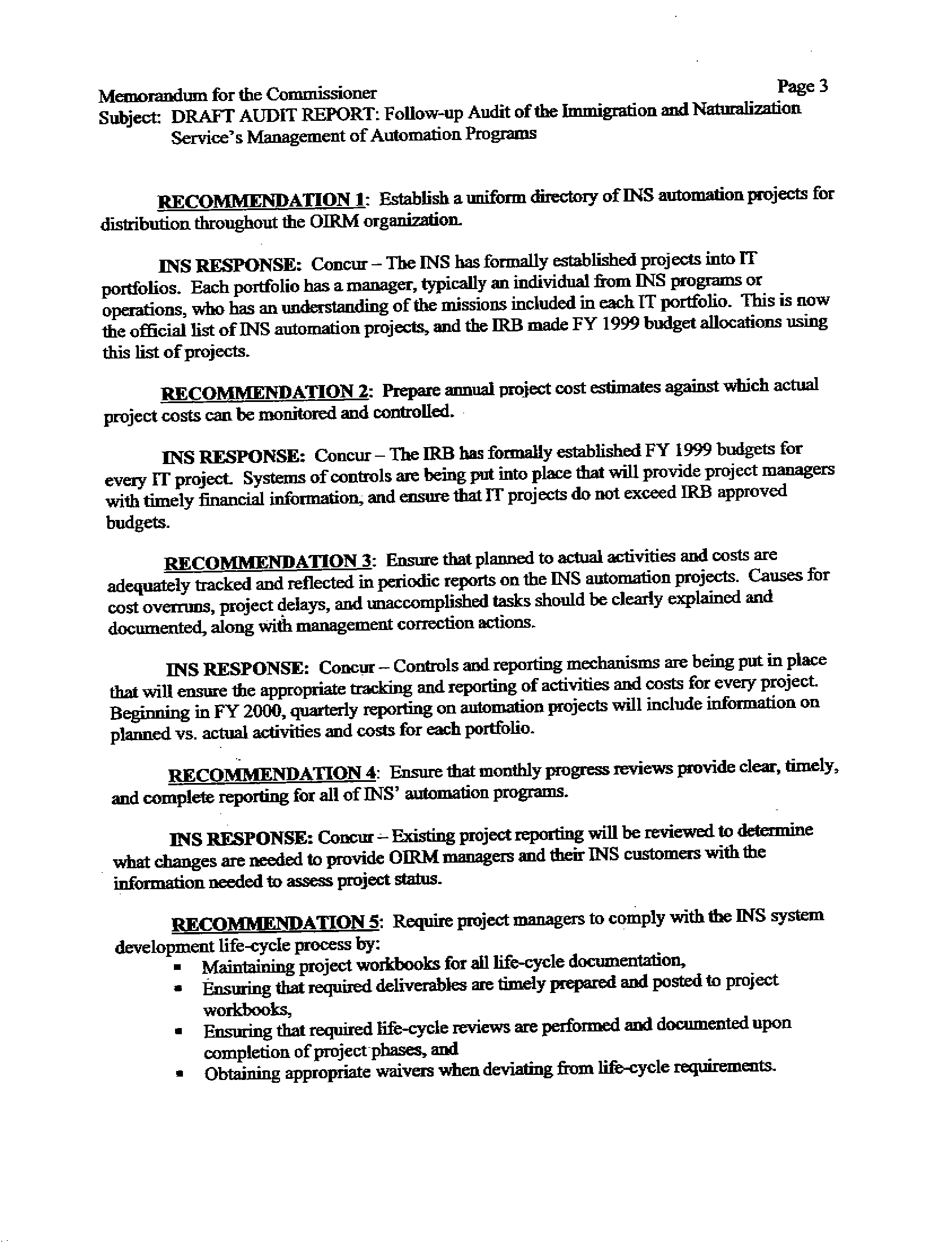
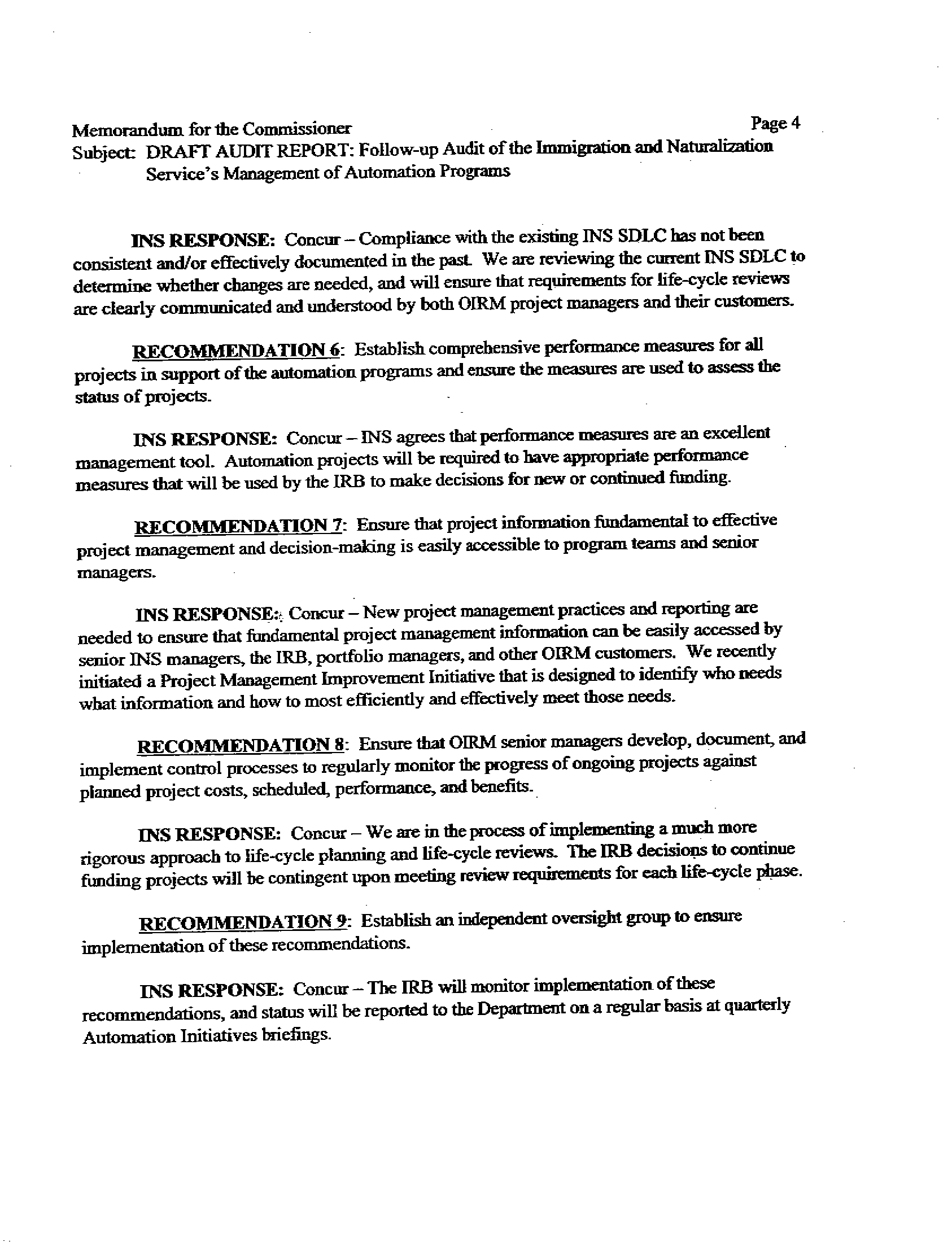
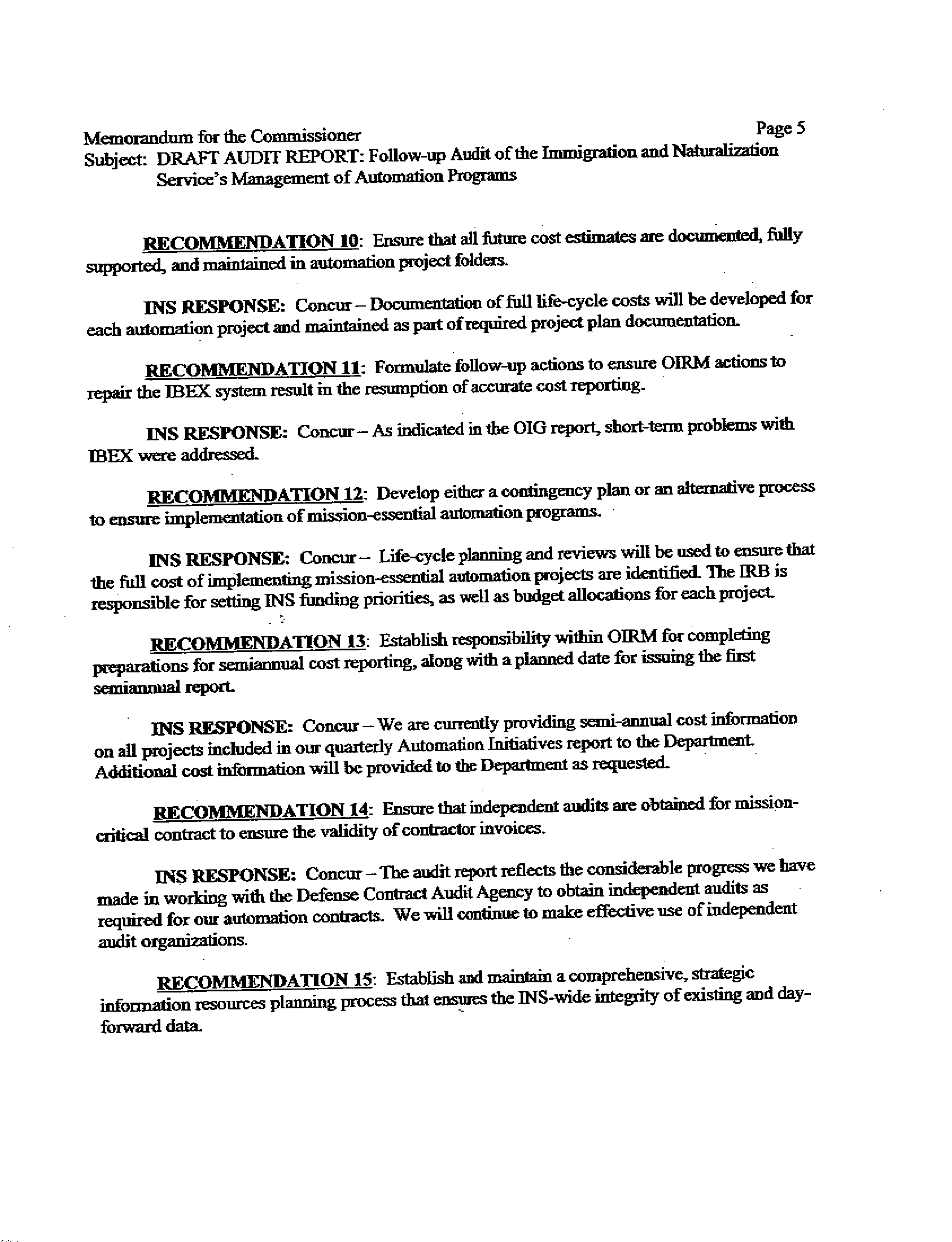
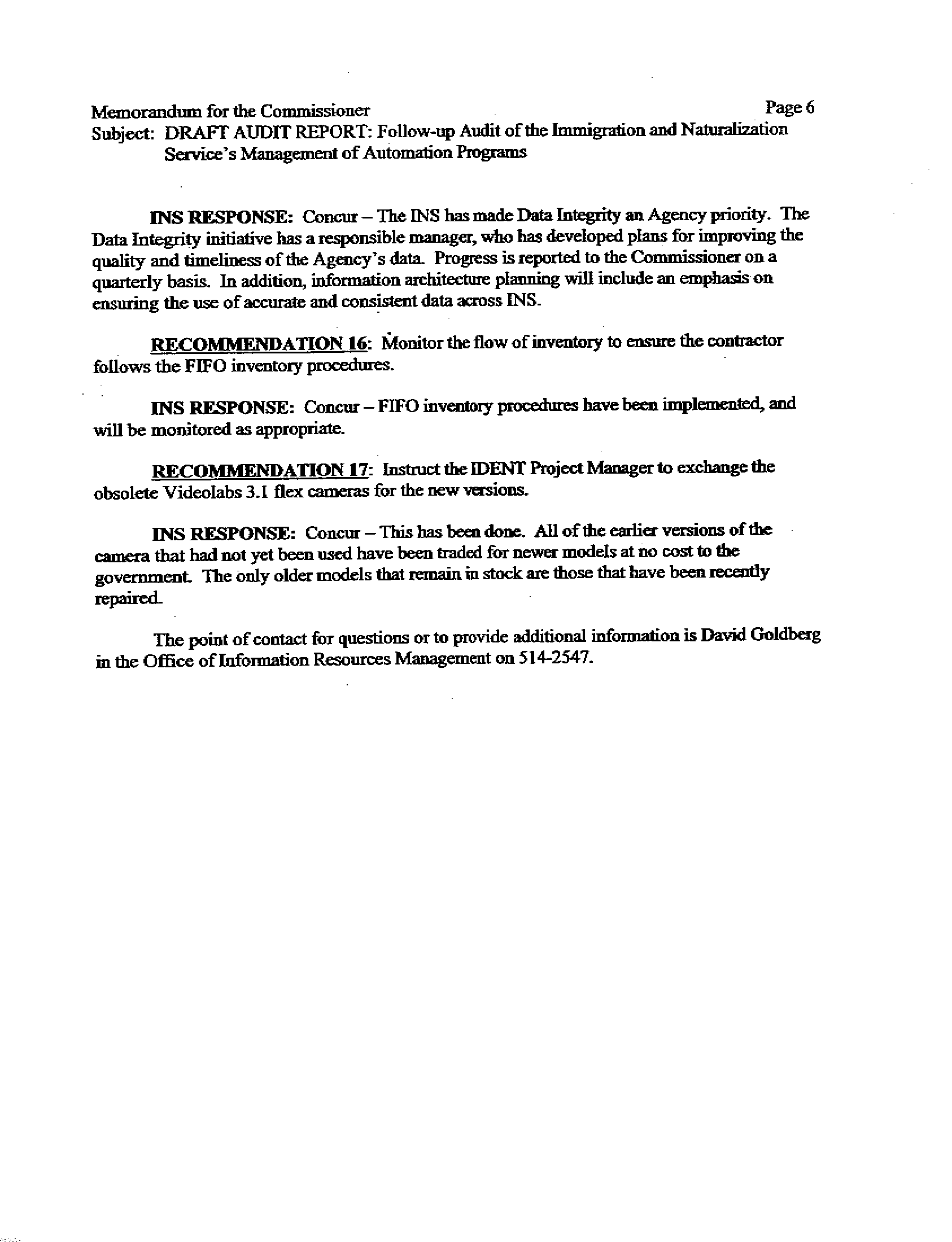
APPENDIX VI
OIG, AUDIT DIVISION
ANALYSIS AND SUMMARY OF ACTIONS
NECESSARY TO CLOSE THE REPORT
Recommendation Number:
- Resolved. This recommendation can be closed when INS provides us with evidence
that it has established a uniform directory of automation projects for distribution
throughout the OIRM organization.
- Resolved. This recommendation can be closed when INS provides us with evidence
that it has prepared annual cost estimates for all projects against which actual project
costs can be monitored and controlled.
- Resolved. This recommendation can be closed when INS provides us with evidence
that it has prepared periodic reports on automation initiatives showing INS tracking of
planned to actual activities.
- Resolved. This recommendation can be closed when INS provides us with evidence
that monthly progress reviews provide clear, timely, and complete reporting for all of
INS' automation projects.
- Resolved.
This recommendation can be closed when INS provides us with evidence that
it is requiring project managers to comply with the INS system development life-cycle
process by:
- maintaining project workbooks for all life-cycle documentation,
- ensuring that required deliverables are timely prepared and posted to project workbooks,
- ensuring that required life-cycle reviews are performed and documented upon completion
of project phases, and
- obtaining appropriate waivers when deviating from life-cycle requirements.
- Resolved. This recommendation can be closed when INS provides us with
comprehensive performance measures established for all projects in support of the
automation programs.
- Resolved. This recommendation can be closed when INS provides us with specific
action taken to ensure that project information fundamental to effective project
management and decision-making is easily accessible to program teams and senior managers.
- Resolved. This recommendation can be closed when INS provides us with evidence
that OIRM managers developed, documented, and implemented control processes to regularly
monitor the progress of ongoing projects against planned project costs, schedules,
performance, and benefits.
- Resolved. This recommendation can be closed when INS provides us with status
reports showing IRB monitoring and implementation of recommendations.
- Resolved. This recommendation can be closed when INS provides us with specific
actions taken to ensure that all future life-cycle costs will be developed for each
automation project and maintained as part of required project plan documentation.
- Resolved. This recommendation can be closed when INS provides us with evidence
that OIRM actions to repair the IBEX system resulted in the resumption of accurate cost
reporting for INS automation projects.
- Resolved. This recommendation can be closed when INS provides us with specific
actions taken as a result of INS' life-cycle planning reviews to ensure implementation of
mission-essential automation programs.
- Resolved. This recommendation can be closed when INS provides us with evidence of
semiannual cost reporting for its automation projects.
- Resolved. This recommendation can be closed when INS provides us with evidence
that the Defense Contract Audit Agency has scheduled or completed audits of INS'
mission-critical contracts to ensure the validity of contractor invoices.
- Resolved. This recommendation can be closed when INS provides us with its
comprehensive, strategic plans for ensuring the INS-wide integrity of existing and
day-forward data.
- Resolved. This recommendation can be closed when INS provides us with evidence
that it has implemented and is monitoring its FIFO inventory procedures.
- Closed. This recommendation is closed based on INS’ actions to trade in
obsolete cameras for newer models.
#####








